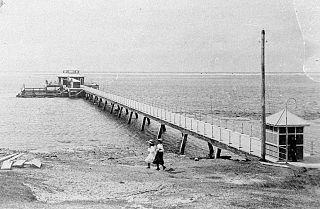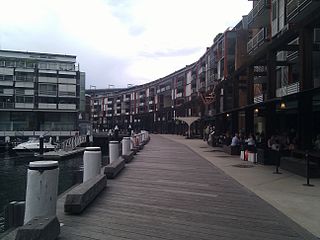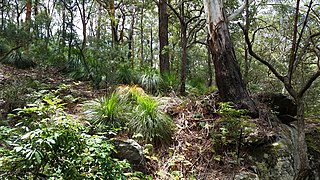
The Parramatta River is an intermediate tide dominated, drowned valley estuary located in Sydney, New South Wales, Australia. With an average depth of 5.1 metres (17 ft), the Parramatta River is the main tributary of Sydney Harbour, a branch of Port Jackson. Secondary tributaries include the smaller Lane Cove and Duck rivers.

Tuggerah Lake, an intermittently open intermediate wave dominated barrier estuary that is part of the Tuggerah Lakes, is located within the Central Coast Council local government area in the Central Coast region of New South Wales, Australia. The lake is located near Wyong and is situated about 90 kilometres (56 mi) north of Sydney.

Milsons Point is a suburb on the lower North Shore of Sydney, in the state of New South Wales, Australia. The suburb is located 3 kilometres north of the Sydney central business district in the local government area of North Sydney Council.

Holman Street ferry wharf is located on the southern side of the Brisbane River in Kangaroo Point, City of Brisbane, Queensland, Australia. It is served by Transdev Brisbane Ferries' CityHopper and the cross-river service to Eagle Street Pier.

Ettalong Beach is a suburb of the Central Coast region of New South Wales, Australia south of Woy Woy on Brisbane Water at the point where it meets Broken Bay, about 80 km north of Sydney. It is part of the Central Coast Council local government area. Ettalong Beach is the natural eastward continuation of Umina Beach and Ocean Beach. The village is serviced by a small retail centre along Ocean View Road.

Mooney Mooney is a suburb of the Central Coast region of New South Wales, Australia, located at the end of a peninsula extending southwards into the Hawkesbury River estuary. 48 kilometres (30 mi) north of Sydney. Mooney Mooney is the location at which the Sydney-Newcastle Freeway and Pacific Highway cross from the Central Coast into Sydney's metropolitan area at Brooklyn in the Hornsby Shire.
Patonga is a suburb of the Central Coast region of New South Wales, Australia, located on the north bank of the Hawkesbury River, southwest of Woy Woy. It is part of the Central Coast Council local government area.
Point Clare is a suburb of the Central Coast region of New South Wales, Australia located 4 kilometres (2 mi) south-west of Gosford's central business district on the western shore of Brisbane Water. It is part of the Central Coast Council local government area.

The Finger Wharf is a heritage-listed former wharf and passenger terminal and now marina, residential apartments, hotel and restaurant located at 6 Cowper Wharf Road, in the inner city Sydney suburb of Woolloomooloo in the City of Sydney local government area of New South Wales, Australia. It was designed by Henry D. Walsh and built from 1910 to 1916 by the Sydney Harbour Trust. It is also known as Woolloomooloo Finger Wharf and Woolloomooloo Wharf. The property is owned by NSW Maritime, an agency of the Government of New South Wales. It was added to the New South Wales State Heritage Register on 18 April 2000. The structure is the longest timbered-piled wharf in the world.

Petrie Bight is a reach of the Brisbane River in Brisbane, Queensland, Australia. The small pocket of land to the north of the bight, centred on the area under the Story Bridge's northern point and around the Brisbane River to Customs House is also known as Petrie Bight; it falls within the suburbs of the Brisbane CBD and Fortitude Valley. However, land to the south of the reach Petrie Bight does not use that name, and is known by its suburb name of Kangaroo Point.

Southport Pier is a pier spanning the Gold Coast Broadwater in Southport, a suburb on the Gold Coast in South East Queensland, Australia. The current pier was constructed in 2009, replacing a previous structure demolished in 1969.

Port Kembla is a man-made cargo port or artificial harbour, with an outer harbour protected by breakwaters and an inner harbour constructed by dredging, located in the Illawarra region of New South Wales, Australia.

Port Douglas Wharf is a heritage-listed wharf at 6 Dixie Street, Port Douglas, Shire of Douglas, Queensland, Australia. It was built in 1904. It was also known as Shipwreck Museum. It was added to the Queensland Heritage Register on 21 October 1992.

Tathra Wharf is a heritage-listed former wharf precinct and now museum and cafe at Wharf Road, Tathra, Bega Valley Shire, New South Wales, Australia. It was built from 1860 to 1862. The property is owned by the Department of Planning and Infrastructure. It was added to the New South Wales State Heritage Register on 2 April 1999.

Fernleigh is a heritage-listed former boatshed and homestead and now residence located at 44-46 Fernleigh Road, Caringbah South in the Sutherland Shire local government area of New South Wales, Australia. It is also known as Mandalay and York House. The property is privately owned. It was added to the New South Wales State Heritage Register on 2 April 1999.

Mulholland's Farm is a heritage-listed residence at 9 Pixie Avenue, Green Point, Central Coast, New South Wales, Australia. It was built in 1907. It was added to the New South Wales State Heritage Register on 2 April 1999.

The Walsh Bay Wharves Precinct is a heritage-listed former wharf precinct, now converted to hospitality and entertainment purposes, at Hickson Road, in the inner city Sydney suburb of Millers Point in the City of Sydney local government area of New South Wales, Australia. It was designed by H. D. Walsh, who also supervised its construction from 1912 to 1921. It includes the MSB Bond Store No. 3 and the Parbury Ruins. It was added to the New South Wales State Heritage Register on 2 April 1999.

The Man O'War Steps is a heritage-listed jetty located at Farm Cove Crescent, in the Sydney central business district, in the City of Sydney local government area of New South Wales, Australia. It was built from 1810. The property is owned by NSW Maritime, an agency of the Government of New South Wales. It was added to the New South Wales State Heritage Register on 18 April 2000. The Steps are located on the eastern bank of Bennelong Point, adjacent to the Sydney Opera House and on the north-western boundary of the Royal Botanic Garden.























